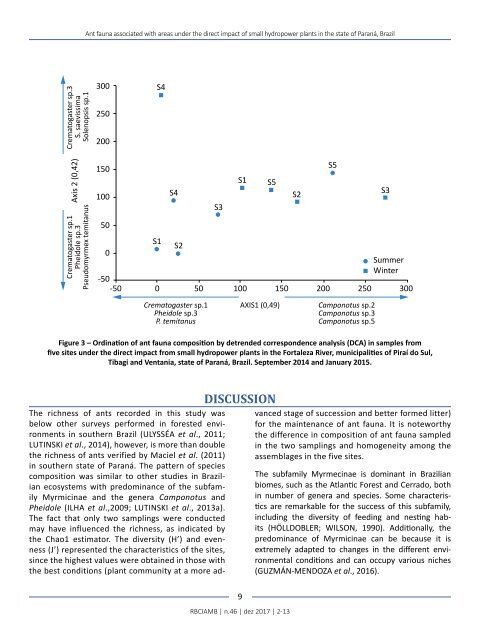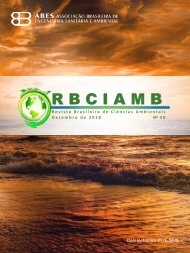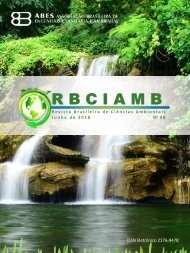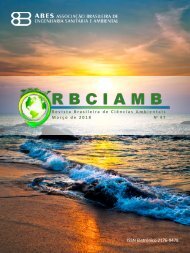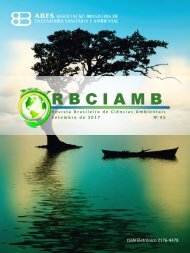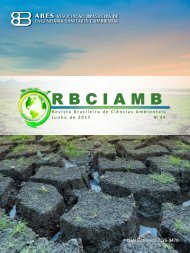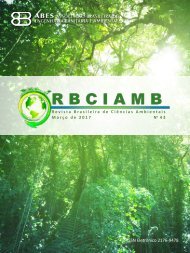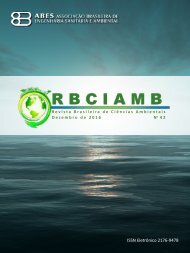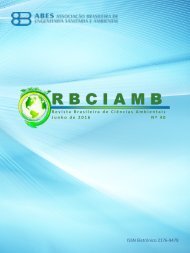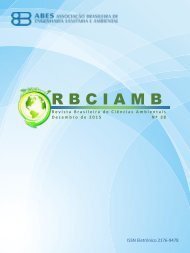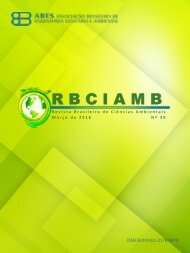Edição 46 RBCIAMB
Create successful ePaper yourself
Turn your PDF publications into a flip-book with our unique Google optimized e-Paper software.
Ant fauna associated with areas under the direct impact of small hydropower plants in the state of Paraná, Brazil<br />
Crematogaster sp.3<br />
S. saevissima<br />
Solenopsis sp.1<br />
300<br />
250<br />
200<br />
S4<br />
Axis 2 (0,42)<br />
Crematogaster sp.1<br />
Pheidole sp.3<br />
Pseudomyrmex temitanus<br />
150<br />
100<br />
50<br />
0<br />
-50<br />
-50<br />
S1<br />
0<br />
S4<br />
S2<br />
50<br />
S3<br />
S1<br />
100<br />
S5<br />
150<br />
S2<br />
200<br />
S5<br />
250<br />
S3<br />
Summer<br />
Winter<br />
300<br />
Crematogaster sp.1<br />
Pheidole sp.3<br />
P. temitanus<br />
AXIS1 (0,49)<br />
Camponotus sp.2<br />
Camponotus sp.3<br />
Camponotus sp.5<br />
Figure 3 – Ordination of ant fauna composition by detrended correspondence analysis (DCA) in samples from<br />
five sites under the direct impact from small hydropower plants in the Fortaleza River, municipalities of Piraí do Sul,<br />
Tibagi and Ventania, state of Paraná, Brazil. September 2014 and January 2015.<br />
DISCUSSION<br />
The richness of ants recorded in this study was<br />
below other surveys performed in forested environments<br />
in southern Brazil (ULYSSÉA et al., 2011;<br />
LUTINSKI et al., 2014), however, is more than double<br />
the richness of ants verified by Maciel et al. (2011)<br />
in southern state of Paraná. The pattern of species<br />
composition was similar to other studies in Brazilian<br />
ecosystems with predominance of the subfamily<br />
Myrmicinae and the genera Camponotus and<br />
Pheidole (ILHA et al.,2009; LUTINSKI et al., 2013a).<br />
The fact that only two samplings were conducted<br />
may have influenced the richness, as indicated by<br />
the Chao1 estimator. The diversity (H’) and evenness<br />
(J’) represented the characteristics of the sites,<br />
since the highest values were obtained in those with<br />
the best conditions (plant community at a more advanced<br />
stage of succession and better formed litter)<br />
for the maintenance of ant fauna. It is noteworthy<br />
the difference in composition of ant fauna sampled<br />
in the two samplings and homogeneity among the<br />
assemblages in the five sites.<br />
The subfamily Myrmecinae is dominant in Brazilian<br />
biomes, such as the Atlantic Forest and Cerrado, both<br />
in number of genera and species. Some characteristics<br />
are remarkable for the success of this subfamily,<br />
including the diversity of feeding and nesting habits<br />
(HÖLLDOBLER; WILSON, 1990). Additionally, the<br />
predominance of Myrmicinae can be because it is<br />
extremely adapted to changes in the different environmental<br />
conditions and can occupy various niches<br />
(GUZMÁN-MENDOZA et al., 2016).<br />
9<br />
<strong>RBCIAMB</strong> | n.<strong>46</strong> | dez 2017 | 2-13


